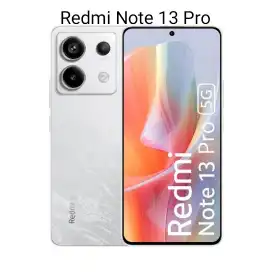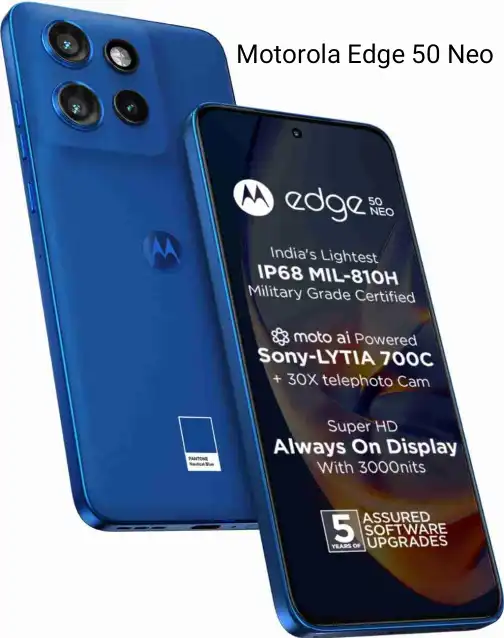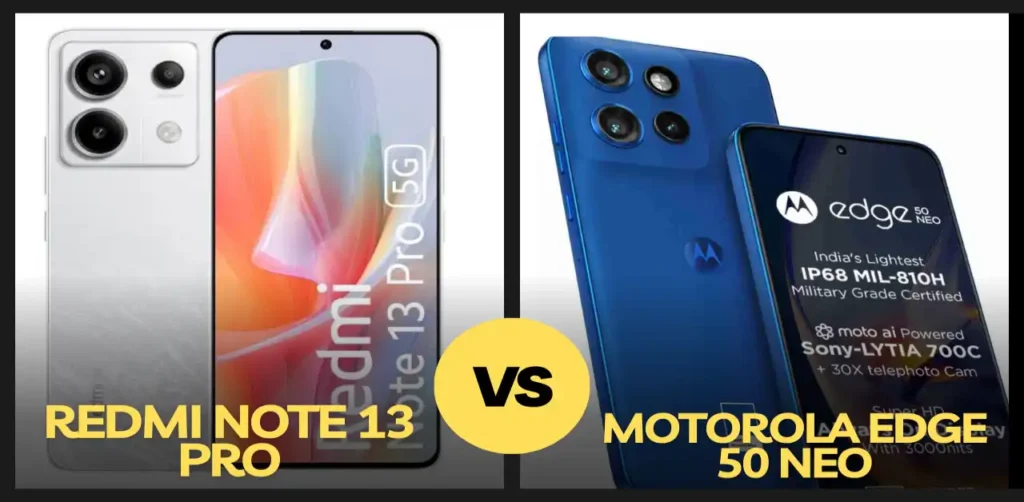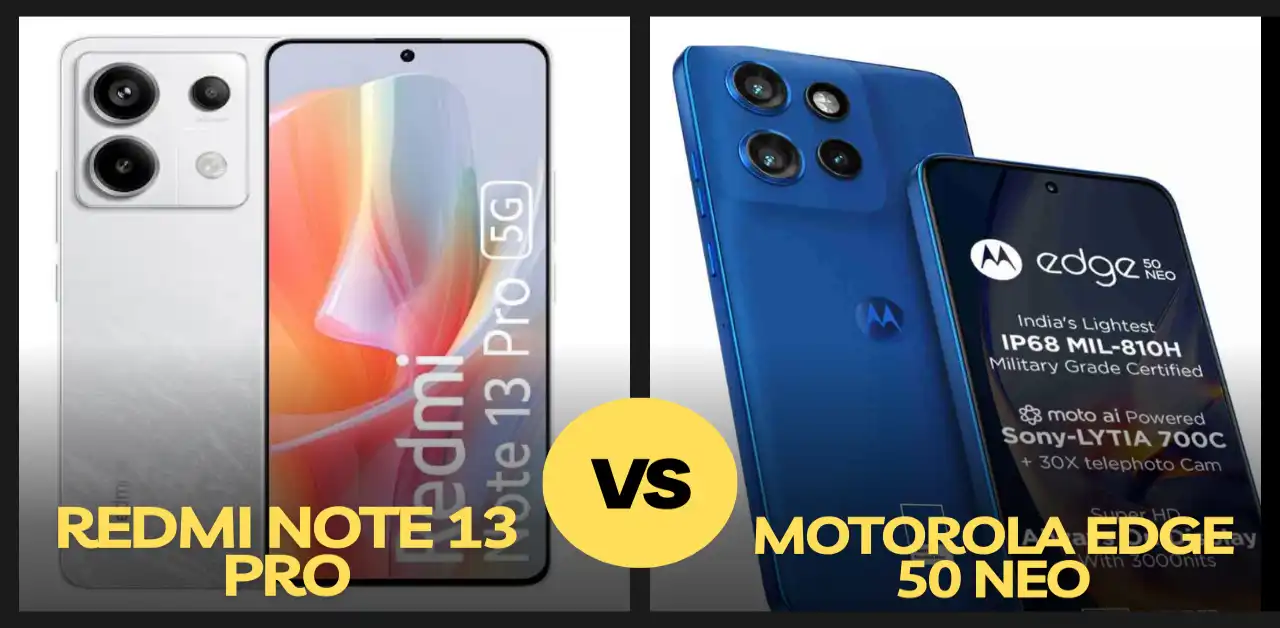Today, in this post, I am comparing Redmi Note 13 Pro Vs Motorola Edge 50 Neo phones to help users unsure which one is the best.
I’ve provided a brief comparison to assist you in making a decision, so you can choose the phone that best suits your needs based on its features.


Camera
- Redmi Note 13 Pro:
- Rear: 200 MP (Wide) + 8 MP (Ultra-Wide) + 2 MP (Macro)
- Front: 16 MP
- Features: OIS, 4K video recording, Dual Video Recording, Macro Mode, HDR
- Motorola Edge 50 Neo:
- Rear: 50 MP (Wide) + 13 MP (Ultra-Wide) + 10 MP (Telephoto)
- Front: 32 MP
- Features: OIS, 4K video recording, Dual Video Recording, Bokeh Portrait, HDR+
Verdict: The Redmi Note 13 Pro boasts a superior 200 MP primary camera, excellent for high-resolution photos, and has solid macro and ultra-wide performance.
However, the Motorola Edge 50 Neo excels with its telephoto lens for zooming and offers a better front camera (32 MP vs 16 MP).
Processor & Performance
- Redmi Note 13 Pro: Qualcomm Snapdragon 7s Gen 2 (Octa-core, 2.4 GHz)
- GPU: Adreno 710
- Fabrication: 4 nm
- Motorola Edge 50 Neo: MediaTek Dimensity 7300 (Octa-core, 2.5 GHz)
- GPU: Mali-G615 MC2
- Fabrication: 4 nm
Verdict: Both phones are built on a 4nm process, making them efficient and powerful. The Snapdragon 7s Gen 2 in the Redmi may offer better compatibility with certain apps and games.
At the same time, the MediaTek Dimensity 7300 in the Motorola might provide better raw performance in some areas due to its faster clock speed (2.5 GHz vs 2.4 GHz).

Display
- Redmi Note 13 Pro:
- 6.67-inch AMOLED, 120 Hz refresh rate
- Resolution: 1220×2712 px, 446 ppi, 1800 nits brightness
- Motorola Edge 50 Neo:
- 6.4-inch P-OLED, 120 Hz refresh rate
- Resolution: 1220×2712 px, 465 ppi, 3000 nits brightness, HDR 10+
Verdict: The Motorola Edge 50 Neo has a higher peak brightness (3000 nits vs 1800 nits), which makes it better for outdoor visibility and supports HDR 10+.However, the Redmi Note 13 Pro offers a slightly larger display.
Build and Design
- Redmi Note 13 Pro:
- Dimensions: 161.15 x 74.24 x 7.98 mm, 187 grams
- Material: Mineral Glass back
- IP54 (Splash-proof)
- Motorola Edge 50 Neo:
- Dimensions: 154.1 x 71.2 x 8.1 mm, 171 grams
- Material: Vegan Leather back
- IP68 (Water-resistant)
Verdict: The Motorola Edge 50 Neo is lighter and has a unique vegan leather back, which gives it a premium feel. It also offers better water resistance with IP68 than Redmi’s IP54.
Battery
- Redmi Note 13 Pro:
- 5100 mAh, 67W fast charging (51% in 15 minutes)
- Motorola Edge 50 Neo:
- 4310 mAh, 68W fast charging, Wireless charging support
Verdict: The Redmi Note 13 Pro has a larger battery (5100 mAh vs 4310 mAh), but the Motorola Edge 50 Neo offers wireless charging, which is a nice addition for convenience.
Software
- Redmi Note 13 Pro:
- Android 13 with HyperOS
- 3 Years Major Updates
- 4 Years Security Updates
- Motorola Edge 50 Neo:
- Android 14 with Hello UI
- 5 Years Major Updates
- 5 Years Security Updates
Verdict: The Motorola Edge 50 Neo has the latest Android 14 out-of-the-box, which might offer some new features and optimizations over the Redmi Note 13 Pro‘s Android 13.
Other Features
- Redmi Note 13 Pro:
- Stereo speakers, Dolby Atmos, 3.5mm audio jack
- NFC: No
- Motorola Edge 50 Neo:
- Stereo speakers, Dolby Atmos, USB Type-C audio
- NFC: Yes
Verdict: Both phones offer Dolby Atmos and stereo speakers, but the Motorola Edge 50 Neo has NFC support, which the Redmi Note 13 Pro lacks.
Conclusion
- Redmi Note 13 Pro: Best for users who want a high-resolution camera, bigger battery, and a slightly larger display.
- Motorola Edge 50 Neo: Better for those who prioritize a premium design, water resistance, better selfie camera, and prefer wireless charging.
Both phones are powerful, so the decision will depend on which features are more important to you (camera, battery, design, etc.).

1 thought on “Redmi Note 13 Pro Vs Motorola Edge 50 Neo Comparison”